Growing ginger is fun and rewarding. With the right tips, you can enjoy ginger’s benefits at home. It’s easy to have fresh ginger by growing it yourself. With patience and practice, you’ll grow ginger like a pro and enjoy its health benefits.
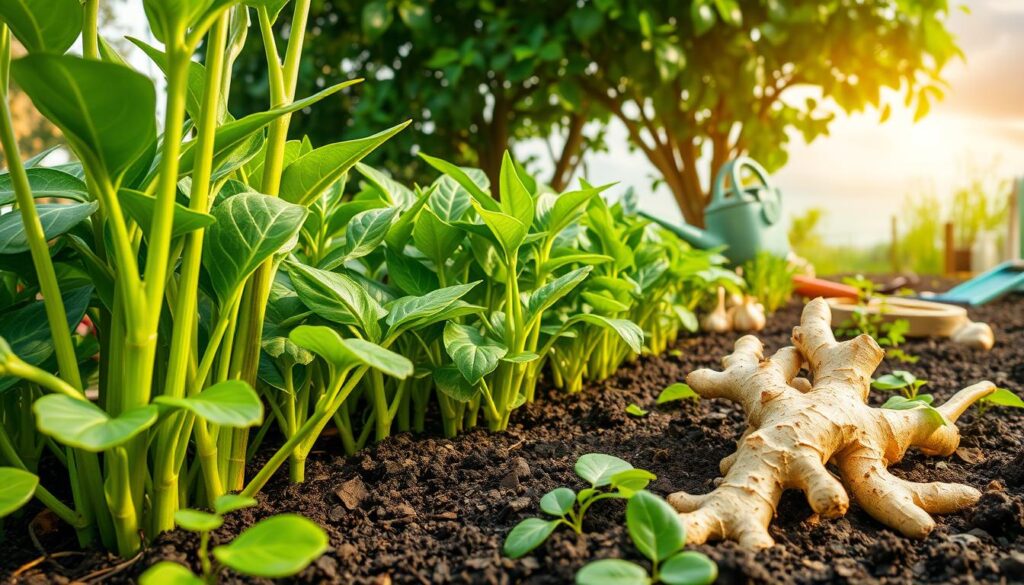
This article will help you start growing ginger. We’ll cover everything from the basics to advanced techniques. You’ll learn about different ginger varieties, soil preparation, and plant care. With this knowledge, you’ll be ready to enjoy growing ginger at home.
Introduction to Growing Ginger
Ginger cultivation is a fun hobby that lets you have fresh ginger at home. By following our tips, you can grow tasty and healthy ginger. Whether you’re new to gardening or experienced, growing ginger is a great hobby.
Key Takeaways
- You can grow ginger at home with the right guidance and techniques.
- Ginger cultivation and its benefits can be enjoyed by anyone, regardless of their gardening experience.
- Ginger farming is a great way to have fresh ginger on hand and enjoy its medicinal properties.
- With the right soil preparation and care, you can grow healthy and delicious ginger at home.
- Growing ginger is a fun and rewarding hobby that can be enjoyed by people of all ages.
- Ginger cultivation is a great way to get started with ginger farming and enjoy the many benefits of ginger.
Understanding Ginger: A Versatile Root Crop
Ginger is a fascinating root crop with a long history. It’s used in many cultures around the world. Knowing its origins and history is key to growing ginger successfully.
Ginger comes from Asia and has been grown for over 3,000 years. Over time, different varieties have emerged.
There are different types of ginger, like baby ginger and mature ginger. Baby ginger is used in Asian dishes and is harvested early. Mature ginger is used in baking and cooking and is harvested when fully grown.
Origins and History
Ginger’s history goes back to ancient China. It was prized for its health benefits and taste. Learning about ginger cultivation will teach you about temperature, humidity, and light needs.
Different Varieties of Ginger
There are many ginger varieties, each with its own taste and texture. Some popular ones include:
- Baby ginger: sweet and tender
- Mature ginger: spicy and fibrous
- Yellow ginger: mild and aromatic
Basic Growing Requirements
To grow ginger, you need the right conditions. This includes:
Temperature: between 64-90°F (18-32°C)
Humidity: high humidity, above 50%
Light: partial shade to full sun
By following these tips, you can grow your own ginger. It’s a delicious and healthy crop.
Essential Tools and Materials for Growing Ginger
To start growing ginger, you’ll need some basic tools and materials. You’ll need a container with good drainage, a potting mix, and a water-soluble fertilizer. Using organic methods is key for healthy growth and to avoid pests and diseases. This way, you can have a big harvest while being kind to the environment.
Here are some essential tools and materials to get you started:
- A container with good drainage to prevent waterlogged soil
- A potting mix specifically designed for ginger cultivation
- A water-soluble fertilizer to provide essential nutrients
- Organic pest control methods, such as neem oil or insecticidal soap
By getting these tools and materials, you’re on your way to growing ginger successfully. Always choose organic farming methods for a healthy and sustainable crop.
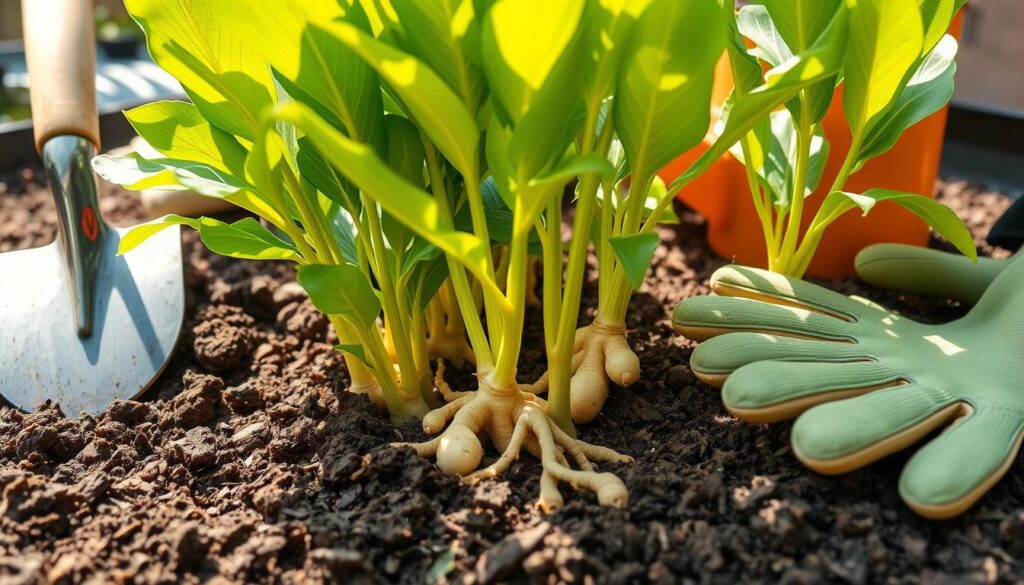
With the right tools and materials, growing your own ginger can be rewarding. Ginger is great for cooking and has many health benefits. By following these tips and using organic farming, you’ll enjoy the benefits of this amazing root crop.
| Tool/Material | Purpose |
|---|---|
| Container with good drainage | Prevents waterlogged soil and promotes healthy root growth |
| Potting mix | Provides essential nutrients and supports healthy plant development |
| Water-soluble fertilizer | Supplies necessary nutrients for optimal plant growth |
Selecting the Right Ginger Rhizomes for Planting
Choosing the right ginger rhizomes is key for a good harvest. A good ginger farming guide will tell you to pick healthy rhizomes. Look at their source, size, and health.
There are organic and commercial rhizomes. Organic ones are pricier but chemical-free. Commercial ones are cheaper but might have chemicals.
Organic vs. Commercial Rhizomes
- Organic rhizomes are grown without chemicals or pesticides
- Commercial rhizomes may be more affordable, but may have been treated with chemicals
Signs of Healthy Ginger Root
A healthy ginger root is firm and plump. It should have no mold or rot. The skin should be smooth and even.
Preparing Rhizomes for Planting
To get your rhizomes ready, cut them into smaller pieces. Make sure each piece has at least one “eye” or bud. Let them dry for a day or two to form a callus. Then, plant them in well-draining soil. With the right rhizomes and proper ginger farming guide, you’ll have a successful harvest.
| Rhizome Type | Characteristics |
|---|---|
| Organic | Grown without chemicals, more expensive |
| Commercial | May be treated with chemicals, more affordable |
Soil Requirements and Preparation Methods
For ginger cultivation and its benefits, the soil is key. As a ginger farming fan, you aim for a rich soil for your ginger plants. You’ll need a mix that drains well and adds organic stuff for better soil health.
Soil pH is also important. Ginger likes a slightly acidic to neutral soil, between 6.0 and 7.0. Use a soil test kit to check your soil’s pH. Adding compost or manure can boost your soil’s fertility and structure, helping your ginger grow well.
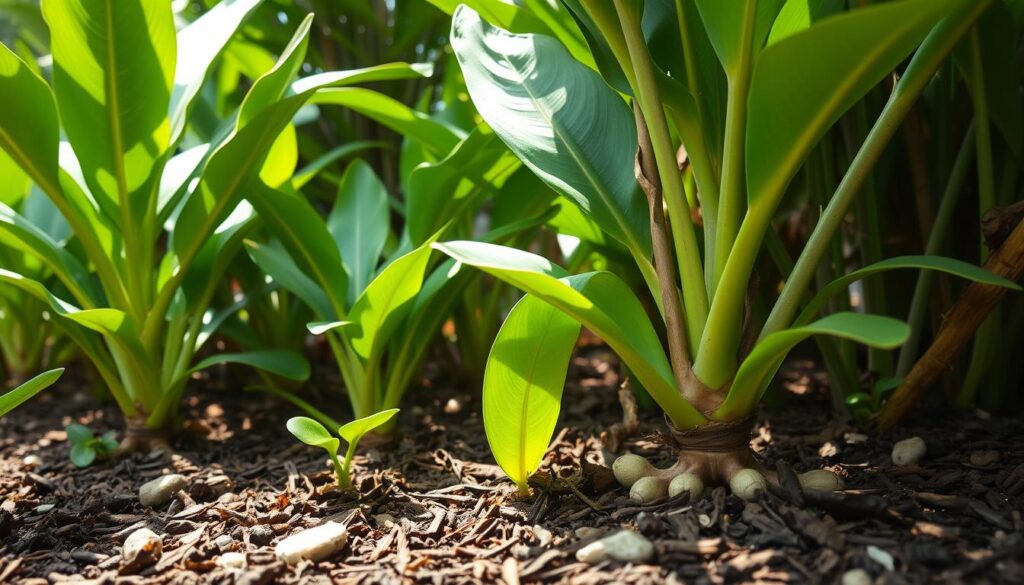
- Use a well-draining potting mix to prevent waterlogged soil
- Add organic matter to improve soil fertility and structure
- Adjust the pH levels to a slightly acidic to neutral range (6.0-7.0)
By following these steps, you can make a great soil for your ginger. This will help your plants grow well and give you a bountiful harvest.
| Soil Requirement | Recommended Level |
|---|---|
| pH Level | 6.0-7.0 |
| Organic Matter | 10-20% |
Ginger Cultivation and Its Benefits: A Complete Guide
Starting to grow ginger is an exciting journey. It offers many benefits, from having a steady supply of ginger to enjoying its health perks. Ginger helps reduce inflammation and aids digestion, making it a valuable addition to your garden.
First, let’s look at how to plant ginger. Choose a spot with enough sunlight and water the soil often. Creating a fertilization plan helps your ginger plants grow strong.
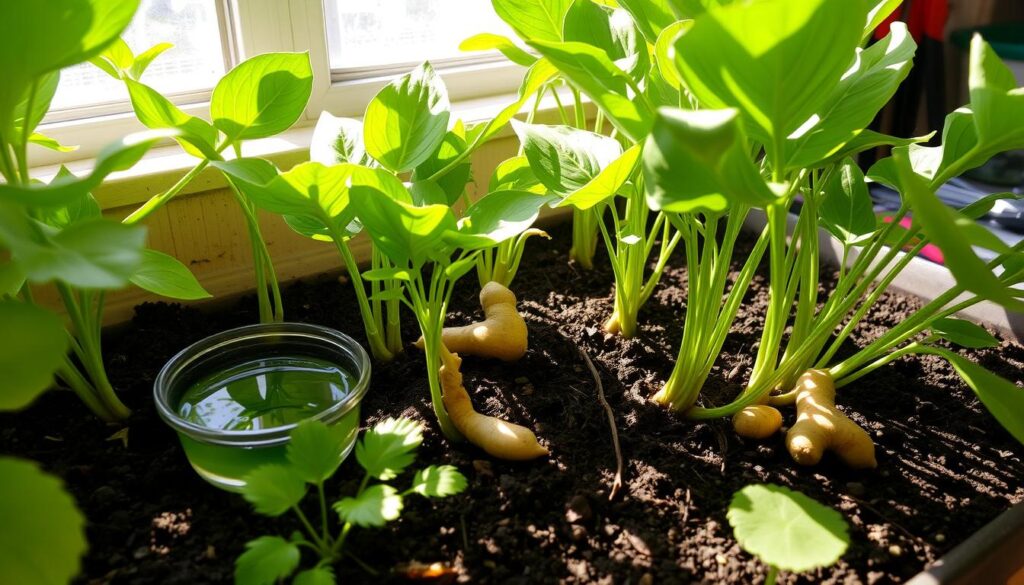
Step-by-Step Planting Process
- Choose a location with partial shade and well-draining soil
- Plant the ginger rhizomes 2-3 inches deep and 6-8 inches apart
- Water the soil regularly, keeping it consistently moist but not waterlogged
By following these steps and keeping up with watering and fertilizing, you’ll grow healthy ginger. Growing ginger is not just for cooking. It also boosts your health in many ways.
Watering Requirements
Watering ginger plants right is key. Too much water can cause root rot, while too little can stress them out. Keep the soil moist but not soggy.
Common Challenges in Growing Ginger
Starting to grow your own ginger can come with some common challenges. These can affect your plants’ health and how well they grow. Knowing how to handle these issues is key to growing great ginger. This includes using ginger for its health benefits.
Pest Management
Pests like aphids, whiteflies, and spider mites can harm your ginger plants. They can damage the plants and lower your harvest. To fight these pests, try using natural methods. This includes bringing in good bugs or using neem oil.
Disease Prevention
Diseases like root rot and leaf spot can hit your ginger plants too. To stop these diseases, make sure your plants have enough air. Also, water them right and get rid of any sick leaves or roots.
Troubleshooting Growth Issues
If your ginger plants are not growing right, like yellow leaves or slow growth, check a few things. Look at the soil moisture, how you’re feeding them, and if they’re getting enough light. Fix these things to help your ginger grow strong and healthy.
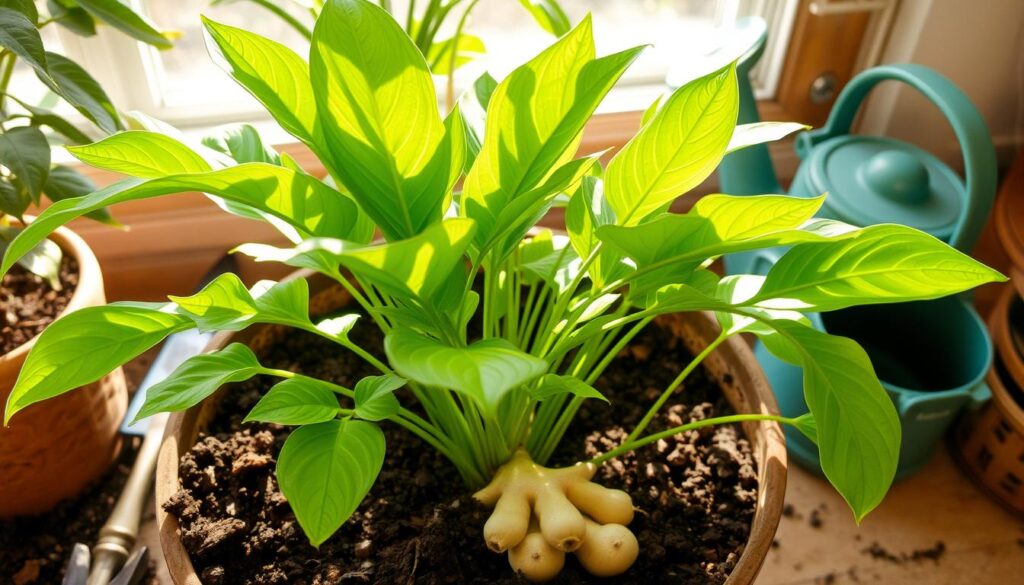
Knowing about these common problems and how to fix them can help your ginger grow well. This way, you can enjoy the many uses and health benefits of growing your own ginger.
| Challenge | Cause | Solution |
|---|---|---|
| Pests | Aphids, whiteflies, spider mites | Introduce beneficial insects, use neem oil |
| Diseases | Root rot, leaf spot | Ensure good air circulation, water carefully, remove infected leaves or roots |
| Growth issues | Yellowing leaves, slow growth | Check soil moisture, fertilization, light exposure, adjust as needed |
Harvesting Your Home-Grown Ginger
As you near the end of your ginger cultivation tips journey, it’s time to harvest your home-grown ginger. This is an exciting moment. You’ll want to make sure you do it at the right time for the best results. In organic ginger farming, timing is key.
To check if your ginger is ready, look for signs of maturity. The leaves will turn yellow and die back. The stalks will start to dry out. You can also check the rhizomes by gently digging around the plant with your fingers. If they’re firm and plump, they’re ready.
Here are some tips for harvesting your ginger:
- Use a fork to carefully loosen the soil around the plant
- Lift the rhizomes out of the ground, taking care not to damage them
- Trim the leaves and stalks from the rhizomes
- Wash the rhizomes gently with water to remove any dirt or debris
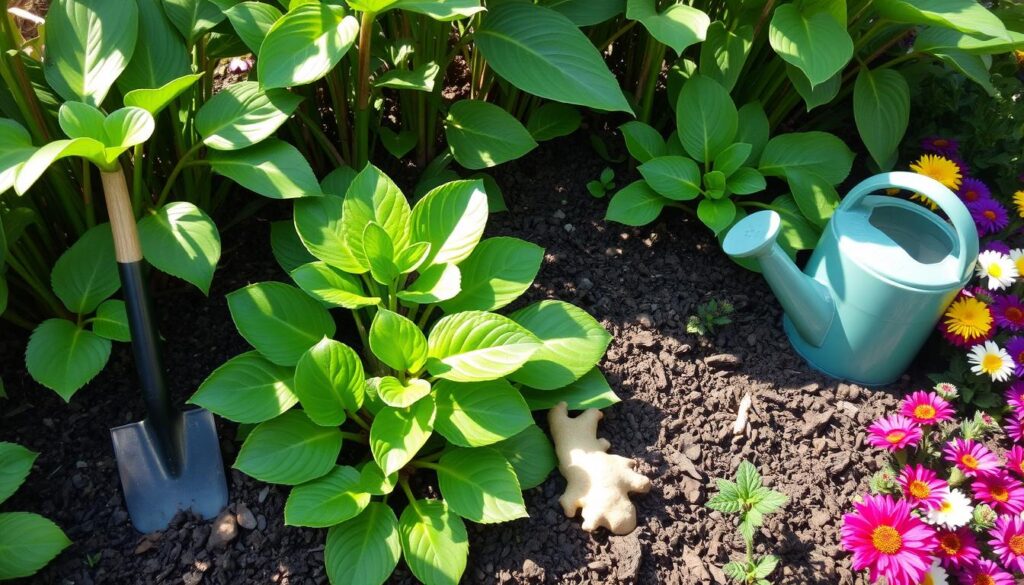
By following these tips and using the right ginger cultivation tips and organic ginger farming techniques, you’ll enjoy your home-grown ginger.
| Harvesting Method | Description |
|---|---|
| Digging | Use a fork to carefully loosen the soil around the plant |
| Lifting | Lift the rhizomes out of the ground, taking care not to damage them |
Storage and Preservation Techniques
After you harvest your ginger, it’s key to store and preserve it. This way, you can enjoy its benefits all year. Knowing the best ways to store and preserve ginger is important. It helps keep your ginger fresh and tasty for longer.
There are several ways to store and preserve ginger, including:
- Fresh ginger storage: Keep the ginger in a cool, dry place or wrap it in a paper bag to keep it fresh.
- Drying methods: Dry ginger to remove moisture, making it easier to store and use in recipes.
- Freezing options: Freezing ginger is another great way to preserve it. It lets you enjoy its flavor and nutritional benefits all year.By using these storage and preservation techniques, you can enjoy the fruits of your labor. You’ll make the most of your home-grown ginger.
Medicinal Properties and Health Benefits
Ginger has been used for centuries for its medicinal properties and health benefits. It can help in many ways, like reducing inflammation and easing nausea. It also improves digestion. The medicinal properties of ginger make it a great natural remedy for many issues.
Some of the key ginger health benefits include:
- Reducing pain and inflammation
- Alleviating nausea and digestive issues
- Improving respiratory health
- Supporting immune function
The medicinal properties of ginger come from compounds like gingerol and shogaol. These compounds have anti-inflammatory and antioxidant effects. By adding ginger to your diet, you can enjoy these benefits and boost your health and well-being.
Culinary Uses for Fresh Ginger
Fresh ginger is a versatile ingredient for many dishes. It can be used in stir-fries, baked goods, or as a marinade. It adds a unique flavor and aroma to soups, stews, and curries.
It’s also great in teas, smoothies, or as a flavor enhancer in sauces. Ginger’s medicinal properties make it valuable in the kitchen. By using it in meals, you can enjoy its benefits every day.
- Making a ginger and lemon tea to aid digestion
- Adding grated ginger to your favorite stir-fry recipe
- Creating a ginger and honey sauce to serve with chicken or fish
- Pickling sliced ginger to use as a condiment
These are just a few ways to use fresh ginger. It can greatly enhance your cooking and daily life.
Creating Value-Added Ginger Products
With your own ginger, you can make tasty products. Ginger farming and ginger cultivation tips open up many options. You can turn fresh ginger into yummy and profitable items.
Some favorite ginger products are:
- Ginger jam, great for toast or cake fillings
- Ginger tea, a calming drink hot or cold
- Ginger oil, useful for cooking and health remedies
Making these products is easy with simple recipes. This lets you enjoy the fruits of your ginger farming labor. With good ginger cultivation tips, you’ll have plenty to make many products. These will highlight your ginger’s special taste and smell.
Trying out different recipes and products shows how key ginger farming and ginger cultivation tips are. They help make top-notch ginger for many uses. Whether for personal use or to sell, the options are vast. The hard work will be worth it.
| Product | Ingredients | Uses |
|---|---|---|
| Ginger jam | Fresh ginger, sugar, lemon juice | Top toast, fill cakes and pastries |
| Ginger tea | Fresh ginger, water, honey (optional) | Soothe digestive issues, enjoy as a healthy beverage |
| Ginger oil | Fresh ginger, carrier oil | Cooking, natural remedies, skincare |
Conclusion: Embracing the Rewards of Growing Your Own Ginger
Growing your own ginger is a rewarding journey. You’ll get fresh, flavorful ginger and enjoy many health benefits. It’s also great for cooking, adding value to your garden.
By growing ginger, you control your food source. You reduce your need for store-bought produce. It also connects you to the earth in a special way.
With what you’ve learned, you can grow, harvest, and preserve ginger. This ensures your family can enjoy its taste and health benefits all year. Take pride in your ginger-growing skills and enjoy the benefits it brings to your life.
FAQ
What are the main benefits of growing ginger at home?
Growing ginger at home means you always have fresh, tasty ginger. It’s full of health benefits. You get better quality than store-bought and can control the growing conditions for the best results.
What are the essential tools and materials needed for growing ginger?
You’ll need a container with good drainage, a potting mix that drains well, and fertilizer. Also, use organic methods to keep your ginger healthy and pest-free.
How do I select the right ginger rhizomes for planting?
Choose organic, healthy rhizomes without blemishes. Make sure they have eyes or buds. Cut them into pieces, each with at least one eye.
What are the soil requirements for growing ginger?
Ginger likes well-draining, rich soil that’s slightly acidic. Add compost or aged manure to improve the soil. Make sure it’s loose for the rhizomes to grow well.
How do I plant and care for ginger plants?
Plant the rhizome pieces 2-4 inches deep and 10-12 inches apart. Keep the soil moist but not too wet. Fertilize every 4-6 weeks to help them grow.
What are some common challenges in growing ginger and how can I address them?
Pests, diseases, and growth issues can happen. Use neem oil for pests and ensure good drainage and air for diseases. Adjust water, light, and nutrients for growth problems.
When and how do I harvest my homegrown ginger?
Harvest when the leaves turn yellow and die, usually 8-10 months after planting. Dig carefully, then rinse the rhizomes. You can take some while leaving the rest to grow.
How can I store and preserve my homegrown ginger?
Store fresh ginger in a sealed bag or container in the fridge for up to 3 weeks. Dry or freeze it for longer storage. This keeps the flavor and health benefits.
What are the medicinal properties and health benefits of ginger?
Ginger is known for its anti-inflammatory, antioxidant, and digestive benefits. It can ease nausea, reduce pain, and improve circulation. Adding ginger to your diet boosts your health.
How can I use fresh ginger in my cooking and beverages?
Use fresh ginger in stir-fries, soups, marinades, and baked goods. It’s great in teas, juices, and smoothies too. Try different recipes to enjoy its unique flavor and aroma.


2 thoughts on ““How to Grow Ginger at Home: Cultivation Tips and Amazing Benefits””